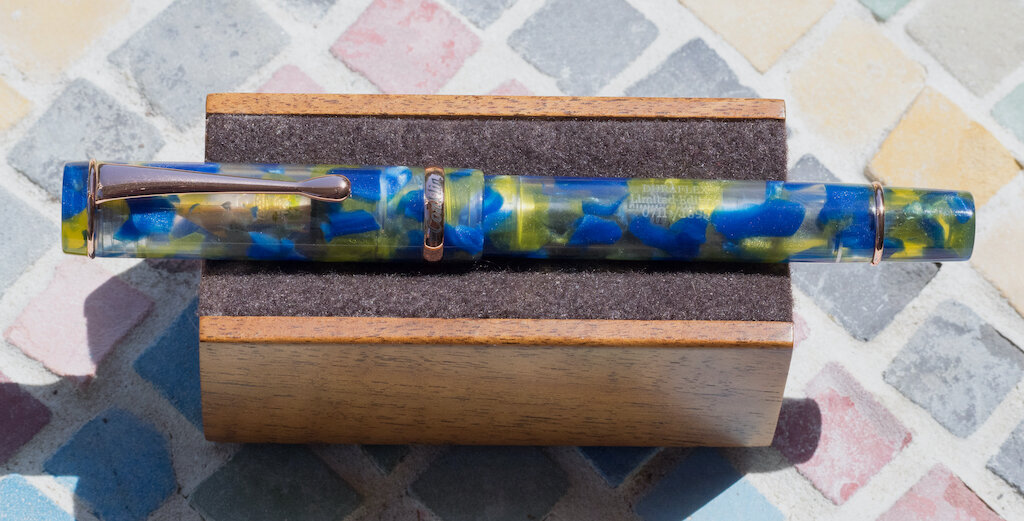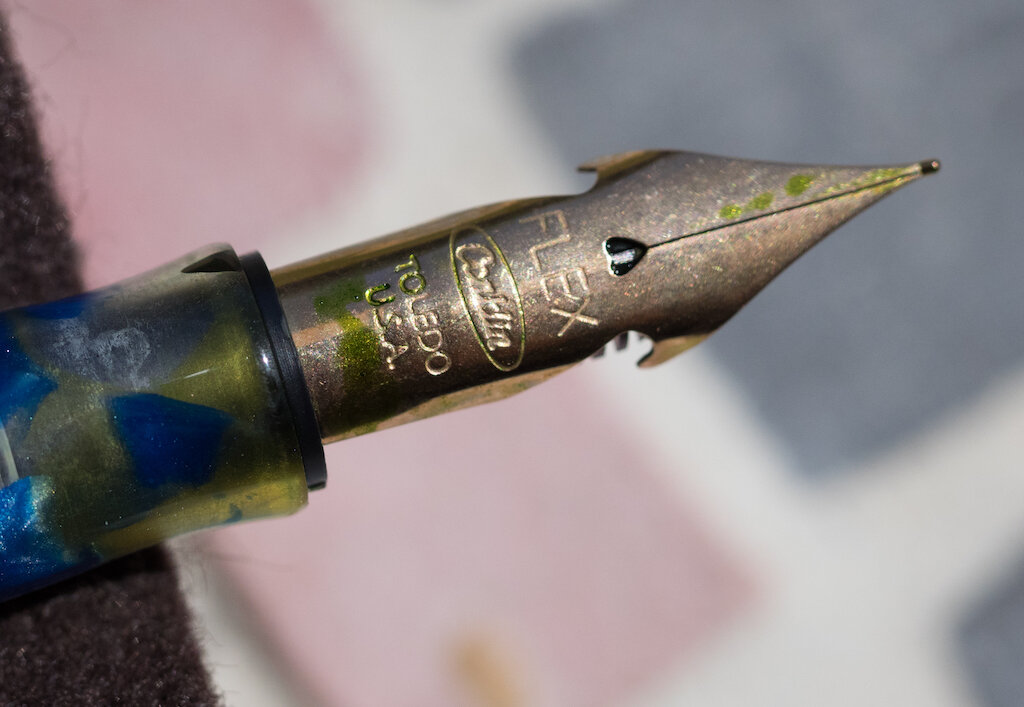(Susan M. Pigott is a fountain pen collector, pen and paperholic, photographer, and professor. You can find more from Susan on her blog Scribalishess.)
Conklin has a new series of fountain pens called Elements, which includes three pens: Earth (black and brown translucent resin with black trim), Fire (black and red translucent resin with silver trim), and Water (blue and green translucent resin with copper trim). Today I’m reviewing Water.
The pen comes packaged in a clamshell box with an outer cardboard sheath that is brightly colored and printed with the Conklin Duraflex Elements label. The box itself has a cream, suede-like interior.
Included with the pen are several cards with information about the filling system, the Omniflex nib, and the Conklin brand. In addition you receive two ink cartridges and a converter.
Water is a beautiful resin. It reminds me a little of the black and gold celluloid on the Omas Lucens. Water is translucent with blue and green flecks (and it’s resin, not celluloid). Still, it’s quite striking. Even my daughter, who often looks at a fountain pen I have in hand and says, “That looks like clown vomit,” remarked on how pretty this pen is.
The barrel is engraved with “Duraflex Limited Edition” and the number. Mine is 711 out of 1898.
This pen comes with copper trims that complement the resin well. The clip has a simple curve with a teardrop-shaped tip. The cap is a screw top and requires only two turns for capping and uncapping.
The cap ring is engraved with “Conklin” on one side and “Duraflex” with moon shapes on the other.
The Duraflex is a medium-sized pen, measuring 5.5 inches/139.7 mm capped, 4.8 inches/121.92 mm uncapped, and 7.0 inches/177.8 mm posted. The grip is a comfortable 9.9 mm in diameter. It weighs only 11 grams unposted, which makes it light in the hand. The pen is well-balanced uncapped, but posting makes it rather unwieldy.
The pen fills via cartridge or converter. The converter is pretty standard, made of mostly plastic, but it pulls up the ink adequately.
I’m always excited to try flex nibs, so I was looking forward to writing with the Omniflex. The nib itself is pretty cool looking with cutouts on the sides, a heart-shaped breather hole, and the word “FLEX” inscribed on the surface, along with “Conklin Toledo, USA.”
The Omniflex Nib instruction card states that the nib is “intricately designed and cut for maximum performance, resembling a bird taking flight . . . . The nib flexes with significant ease . . . .”
Well . . . I would beg to differ on the “significant ease” part. This nib is stiff. Very stiff. And getting any flex out of it requires a good amount of pressure. That said, you can get some decent line variation if you work hard. I inked Water with Kobe University Town Green and wrote out the alphabet in a Midori MD notebook. You can see the line variation in the photos below. In addition, you can see where the pen started railroading and stopped writing when I did line tests.
I added some Vanness White Lightning Ink Additive to the ink and refilled the pen. This helped ink flow significantly and I was able to write at my normal speed (without flex) without any skipping or railroading.
However, this is one of the worst nibs I’ve ever used. Not only is it difficult to flex, when you write normally the nib is rough and extremely unpleasant. I took macro photos of the nib in an attempt to see what the problem was. The tines did not look misaligned from the front.
But the photos I took of the nib’s top and bottom revealed two issues. First, one tine is slightly shorter than the other. Second, one tine is quite a bit thinner than the other. It appears to me that this nib was just poorly made. Unfortunately, these sorts of issues can’t be fixed with a little micromesh.
It’s quite a shame that the nib is in such bad shape out of the box. If this weren’t a review pen, I’d return it and request a replacement. I read quite a few reviews of the Omniflex nibs, and most were negative, which suggests to me that there’s a quality control issue here. Some owners replaced their Omniflex nibs with regular Conklin nibs with good results, but, as far as I can tell, there are no copper-colored regular nibs that would match the trim on Water.
I’m sad that I finally have a fountain pen that is "Daughter-Approved™ but is unusable due to the nib. I may just grit my teeth and write with the nib for now, but I’ll likely wind up buying a regular Conklin nib to replace the Omniflex.
You can purchase any of the Conklin Elements pens from JetPens for $60.00. Keep in mind that right now JetPens is not offering free shipping for orders over $50.00 and shipping takes quite a bit longer than normal.
(JetPens provided this product at no charge to The Pen Addict for review purposes.)
Enjoy reading The Pen Addict? Then consider becoming a member to receive additional weekly content, giveaways, and discounts in The Pen Addict shop. Plus, you support me and the site directly, for which I am very grateful.
Membership starts at just $5/month, with a discounted annual option available. To find out more about membership click here and join us!























